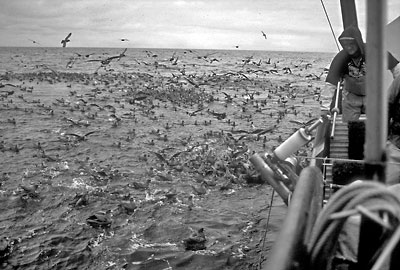Partner Profile: NOAA Fisheries—September 2004
Beached Birds: A COASST Field Guide is now the definitive tool for identifying dead marine birds on land and water. Thanks to a partnership with NOAA Fisheries, Beached Birds is now among the reference materials used by observers aboard Alaska fishing vessels.
What’s an observer? Observers are trained biologists aboard commercial fishing boats who collect catch and bycatch data and monitor fishery interactions with marine mammals and birds. Although no fishery targets birds, many birds congregate around fishing vessels in search of a handout. Seabirds, such as albatrosses and fulmars, drown when they snatch baited hooks from longline fishing vessels and are pulled under water.

A feeding frenzy forms around this fishing boat in Alaska. (Washington Sea Grant Program)
The US Fish and Wildlife Service is primarily responsible for managing seabird populations, but NOAA Fisheries is leading the charge to address seabird bycatch. According to Kim Rivera, National Seabird Coordinator for NOAA Fisheries, “If fishery inter-actions are negatively impacting an ecosystem, it’s our responsibility to identify the issues and work collaboratively with stakeholders to find solutions.”
Partnering with COASST is one way NOAA Fisheries is addressing seabird bycatch issues. Bill Karp, Director of the North Pacific Groundfish Observer Program, says Beached Birds has been well received by the nearly 200 observers in his program, which is bigger than all other NOAA Fisheries observer programs combined. “We’ve never had a field guide like this to identify dead birds until now, and our observers say it’s a very useful tool,” he says. “It’s easy to carry and use in the field, making identification simple.”
According to Karp, seabird bycatch in the North Pacific groundfish fishery is uncommon, and observers usually encounter common species like Northern Fulmars when it occurs. Incidental take of less common species like albatrosses, including the endangered Short-tailed Albatross, can have negative impacts. Observer data helps Rivera and her colleagues at other agencies in the US and abroad understand the impact of seabird bycatch and take appropriate action.
“The good news is there are measures we can take to reduce seabird bycatch that can be easily implemented,” Rivera says. “In general, fishers are very in tune with ecosystem management because negative impacts can result in fishery closures. The longline vessels in Alaska, for example, have been receptive to using devices (bird-scaring lines) that aim to reduce seabird bycatch.”
Although the US has been proactive in addressing seabird bycatch, Rivera says international cooperation is critical to the success of current efforts. “Seabirds don’t recognize national boundaries, so there is an important international component to this work,” she explains. “Even if we improve the situation in the US, we have to look at the global picture. Part of my job is to work at coordinating some of these global efforts so we can effectively bring about change and reduce the fishery interactions with seabirds.”
Helping natural resource management agencies and other stakeholders conserve our seabirds through long-term monitoring and through valuable products like Beached Birds is at the heart of COASST’s work. We commend NOAA Fisheries for its efforts to work with scientists and industry representatives to reduce seabird bycatch.